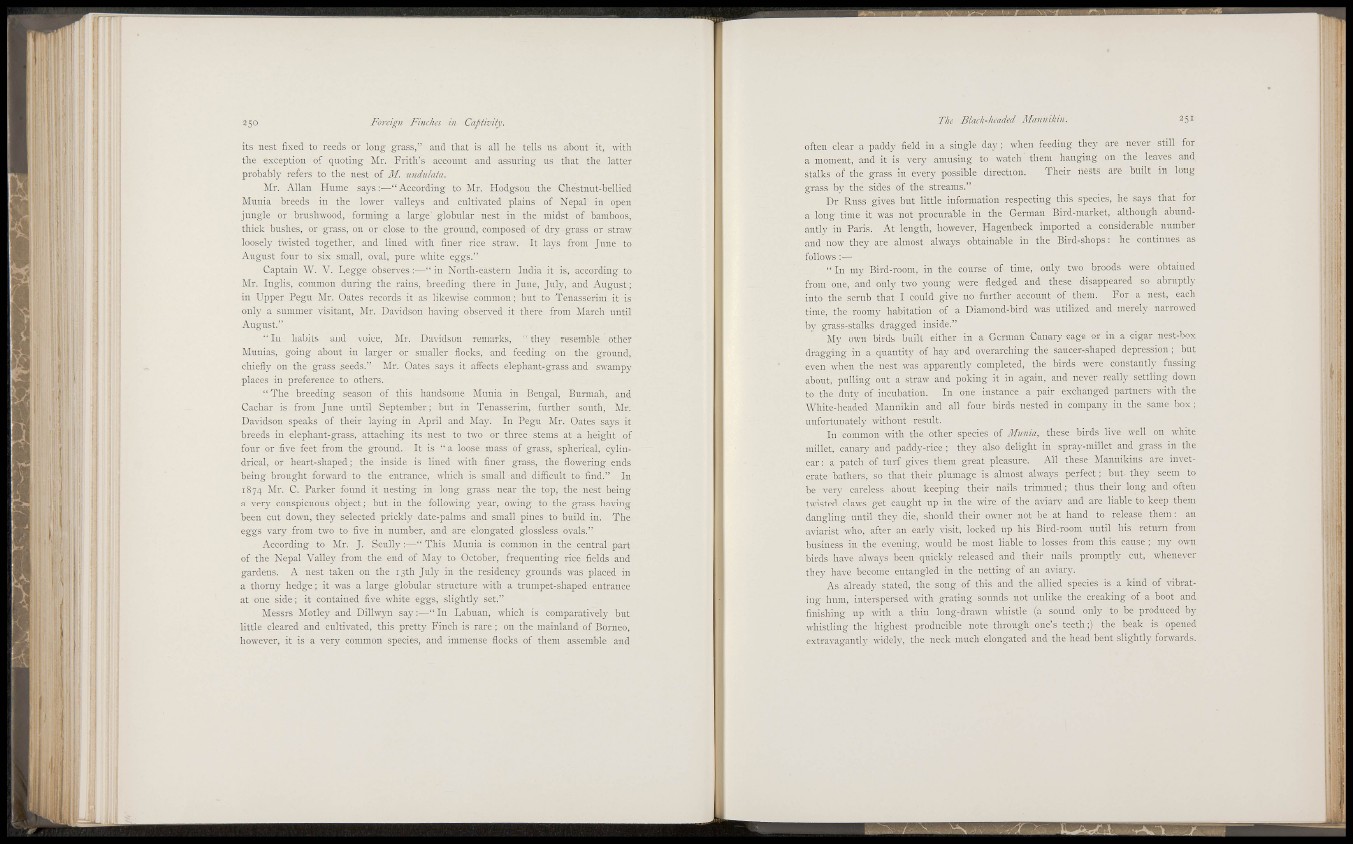
t
I' :
!;i ' ;
i
1' '•
: >
.:í i! : ^
Y ;
• i
! !
í :
•1 ' 1 li .
i
i i l : iJ
250 Foreign Finches in Captivity.
its nest fixed to reeds or long grass," and tliat is all lie tells us abont it, with
tlie exception of quoting Mr. Fritli's account and assuring us that the latter
probably refers to the nest of M. undulata.
Mr. Allan Hume says:—"According to ^Ir. Hodgson the Chestnut-bellied
Mnuia breeds in the lower valleys and cultivated plains of Nepal in open
jungle or brushwood, forming a large globular nest in the midst of bamboos,
thick bushes, or grass, on or close to the ground, composed of dry grass or straw
loosely twisted together, and lined with finer rice straw. It lays from June to
August four to six small, oval, pure white eggs."
Captain W. V. Legge observes :—" in North-eastern India it is, according to
Mr. Inglis, comnion during the rains, breeding there in June, Jnly, and August;
in Upper Pegu Mr. Gates records it as likewise common; but to Tenasserini it is
only a summer visitant, Mr. Davidson having observed it there from ]\Iarch until
August."
" In habits and voice, Mr. Davidson remarks, " they resemble other
Munias, going about in larger or smaller flocks, and feeding on the ground,
chiefly on the grass seeds." Mr. Gates says it affects elephant-grass and swampy
places in preference to others.
" T h e breeding season of this handsome Munia in Bengal, Burmah, and
Cachar is from June until September; but in Tenasserini, further sonth, Mr.
Davidson speaks of their laying in April and May. In Pegu Mr. Gates says it
breeds in elephant-grass, attaching its nest to two or three stems at a height of
four or five feet from the ground. It is " a loose mass of grass, splierical, cylindrical,
or heart-shaped; the inside is lined with finer grass, the flowering ends
being brought forward to the entrance, which is small and difficult to find." In
1874 Mr. C. Parker found it nesting in long grass near the top, the nest being
a very conspicuous object; but in the following year, owing to the grass having
been cut down, they selected prickly date-palms and small pines to build in. The
eggs vary from two to five in number, and are elongated glossless ovals."
According to Mr. J. Scull}' :—" This Mnnia is comnion in the central part
of the Nepal Valley from the end of May to Gctober, frequenting rice fields and
gardens. A nest taken on the 13th July in the residenc}' grounds was placed in
a thoni3' hedge; it was a large globular structure with a trumpet-shaped entrance
at one side; it contained five white eggs, slightly set."
Messrs Motley and Dillwyn say:—"In Labnan, which is comparatively but
little cleared and cultivated, this pretty Finch is rare ; on the mainland of Borneo,
however, it is a very comnion species, and immense flocks of them assemble and
The Biack-hcaded Mtuinikin. 251
often clear a paddy field in a single daj- ; when feeding the}' are never still for
a moment, and it is ^•ery amusing to watch them hanging on the leaves and
stalks of the grass in every possible direction. Their nests are built in long
grass by the sides of the streams."
Dr Rnss gives but little information respecting this species, he says that for
a long time it was not procurable in the German Bird-market, although abundantly
in Paris. At length, however, Hagenbeck imported a considerable number
and "now they are almost always obtainable in the Bird-shops: he continues as
follows :—
" In my Bird-room, in the course of time, only two broods were obtained
from one, and only two young were fledged and these disappeared so abruptly
into the scrub that I could give no further account of theni. For a nest, each
time, the roomy habitation of a Diamond-bird was utilized and merely narrowed
by grass-stalks dragged inside."
My own birds built either in a German Canary-cage or in a cigar nest-box
dragging in a quantit}' of ha)' and overarching the saucer-shaped depression ; but
even \\-heu the nest was apparently completed, the birds were constantly fussing
about, pulling ont a straw and poking it in again, and never really settling down
to the dut5' of incubation. In one instance a pair exchanged partners with the
White-headed Mannikin and all four birds nested in company in the same box ;
unfortunately without result.
In common with the other species of Munia, these birds live well on white
millet, canai-)- and paddy-rice ; they also delight in spray-millet and grass in the
ear: a patch of turf gives them great pleasure. All these Mannikins are inveterate
bathers, so that their plumage is almost always perfect ; but they seem to
be vei-}- careless about keeping their nails trimmed; thus their long and often
twisted claws get caught up in the wire of the aviary and are liable to keep them
dangling until they die, should their owner not be at hand to release them : an
aviarist who, after an early visit, locked up his Bird-room until his return from
business in the evening, would be most liable to losses from this cause ; ni}' own
birds have alwaj-s been quickly released and their nails promptly cut, whenever
they have become entangled in the netting of an aviary.
As airead}- stated, the song of this and the" allied species is a kind of vibrating
hum, interspersed with grating sounds not unlike the creaking of a boot and
finishing up with a thin long-drawn whistle (a sound only to be produced by
whistling the highest producible note through one's teeth;) the beak is opened
extra^•ao-anth• wideh', the neck much elongated and the head bent slightly fonvards.
! :i
m
l i